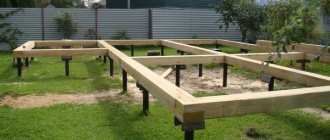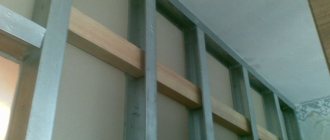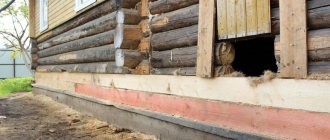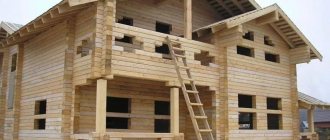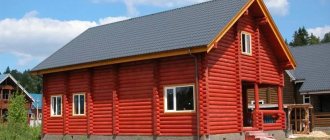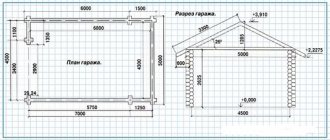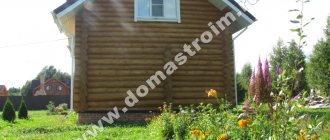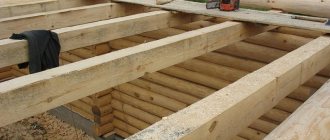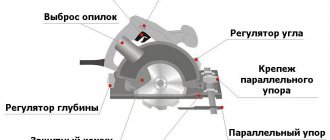The foundation is the foundation of the house. The heavier the house, the more solid the foundation should be. Since a wooden house is relatively light, there may be several options for its foundation. But this does not mean that the choice should be approached carelessly - here it is doubly important to choose the right option, taking into account the complexities of the natural material, because organic matter can begin to deteriorate at the point of exposure to moisture, air and soil three times faster. Plus, the financial issue often comes first. As a result, which foundation is best for a wooden house has to be chosen based on the landscape of the site and the available budget.
The foundation for a wooden house can be made from different materials Source stroy-dom-pravilno.ru
Online foundation calculator
To find out the approximate cost of various types of foundations, use the following calculator:
Concrete strip
The strip foundation for a wooden house is one of the most beloved by our compatriots and, perhaps, the most reliable. Its width is the same around the entire perimeter, and leaves 50 cm “plus” to the width of the walls.
It is divided into three subspecies: deep, shallow and non-buried. Deeply buried is designed for “difficult” conditions: in the presence of basement premises (garage, basement), multi-story buildings, heaving soil on the site, large freezing depth. It is designed to hold the building stably even when weather conditions change and the ground moves. It is believed that such a base should be buried at least 200 mm lower than the freezing depth (the values for a certain latitude are known and can be easily recognized from the reference book).
Classic strip foundation for a wooden house Source tr.decorexpro.com
If the soil allows, then for the construction of low-rise wooden houses, a shallow foundation is most often used - it is buried to a depth of about 500-700 mm, which, although less than the freezing depth, is quite enough to support a light-weight house. And, of course, it will cost much less than a deep-seated belt one.
In the case of very light buildings (sheds or utility rooms), you can get by with a shallow foundation. This type of foundation can be made of concrete or brick, stone or blocks.
A relative novelty on the construction market is a foundation made of permanent formwork, which consists of ready-made elements that are combined into blocks, and then concrete is poured into them.
A non-buried foundation is essentially a plinth on a sand cushion. Source postroim-svoi-dom.ru
The production time for any strip foundation is about a month, since after pouring it is necessary to wait a certain time until the concrete reaches its design strength.
Slab concrete monolithic
A slab foundation is simply a large concrete slab. This is a good choice for heaving and mobile soils, since the slab base has the ability to move along with the soil when it shifts. You should not think that the house will move around the site - moving soil means displacements of a couple of centimeters per year, but even such values can cause cracks to appear on the walls when using a strip base.
Making a monolithic foundation cannot be called an easy task - in terms of installation time, they are approximately equal to those of a strip foundation. It also requires clearing the site, deepening it, pouring concrete - and, given the harsh conditions, some experts ask for a grade no lower than M400, in principle, given the cost, you can get by with M150, but these are very minimal requirements. A big problem is also the uniform drying of the slab surface (a large area dries poorly, and it will take a long time to dry completely and begin the next stage of work). It will also be necessary to arrange a sand cushion for cement, a blind area on the finished foundation and waterproofing (as a means of protecting concrete from water - film or special compounds).
Ready slab foundation Source stroidom-shop.ru
Pile: steel screw or concrete driven
A pile foundation for a wooden house is a good choice for a site where there are problems with groundwater, and, in addition, the site itself has unevenness, the leveling of which will require significant effort. Proper calculation of the pile field makes such a foundation reliable and stable. In addition, the cost of a pile foundation is significantly lower than a concrete one, and installation is carried out in one day.
The main disadvantage is that with a pile foundation it will not be possible to create a basement or ground floor in the house. Auxiliary buildings on the same foundation as the piles are undesirable - due to the elevation above the ground. Entering a garage, for example, will not be very practical.
What type of base to choose
As a rule, a strip foundation from different materials or a columnar base is made for a log house. The specific type is determined based on the results of a soil study for its composition and basic properties, as well as according to the level of groundwater flow.
Therefore, before planning to build a house, it is better to contact a company that provides geodetic services. The company’s specialists not only determine the characteristics of the soil, but also recommend the type of foundation, as well as materials for its manufacture.
You still need to know for yourself when it is best to use which foundation for a log house on a certain type of soil:
- The strip base, usually made of reinforced concrete, is mainly used on very wet soils or soils with high groundwater levels, such as peat or marshy soils.
A variant of a monolithic strip foundation for a wooden cottage.
Such soils mainly consist of soft, fertile soil. In this case, the depth of the foundation depends on the weight of the structure; the heavier the house, the more solid the foundation must be used. And also on the presence or absence of a basement. - In addition to reinforced concrete, a strip foundation for a log house can be made from brickwork, however, this option is quite expensive and is therefore not used often.
- If the soil contains sand, clay or loam, as well as rocky inclusions, in principle, any type of foundation can be installed. However, there are some limitations to the columnar base. If there are large fragments of rock in the ground, there is a high probability of encountering such an area when drilling a well. And since all work is carried out, as a rule, manually, it is unlikely that it will be possible to break through the rocky rock.
Columnar foundation for a log building - A columnar foundation for a log house is mainly used on dry, densely structured soils that are not subject to movement, and soils with a large amount of sand.
Video description
What are the pros and cons of a pile screw foundation? Is it possible to make a high-quality foundation for little money? Watch in this video:
Pile foundation - screw and concrete Source stroy-dom-pravilno.ru
See also: Catalog of wooden house projects presented at the Low-Rise Country exhibition.
Log house
A log house is the walls of a house made of solid logs. In the corners of a wooden house, logs are connected into so-called crowns. At the bottom of the log, a piece of wood is cut out the width of the transverse diameter of the log. Wooden elements in the corners of the house form locking systems that do not require additional strengthening. This confirms the popular expression - to build a house without a single nail.
Such houses are most often built in areas where timber is available to consumers at a low price. Such places include Central, Eastern Siberia and the Far East. Although it is worth noting that the popularity of building private houses from solid wooden elements has increased widely in all regions of our country.
The low specific gravity, excellent thermal insulation qualities, durability and environmental friendliness of wood are an undeniable advantage over other building materials.
Video description
What are the features of concrete driven piles? We'll talk about pile foundations in our video:
Columnar: brick, block or concrete
Columnar foundations do exist as a separate type of foundation, but it must be noted right away that they cannot be used for the construction of a residential building.
In general, this is an inexpensive and easily erected foundation, which is a hole 50-70 cm deep, at the bottom of which sand and crushed stone cushions are laid, on top of which the pillar itself is built.
The methods for making “pillars” are completely different - bricks, pouring concrete into formwork, asbestos pipes, ready-made blocks. As with any technology that uses concrete, care should be taken to ensure that sand cushions, formwork and reinforcement are installed when making the bases on site.
Columnar foundation poured and made of blocks Source nauka-i-religia.ru
The distance between the pillars, regardless of unevenness, should not be more than 1.5-2 m; in addition, pillars must be present at the corners of the building and at the intersections and junctions of walls. Columnar foundations are installed almost everywhere, with the exception of floating areas (areas completely unsuitable for construction), using special device technologies - for example, TISE, where the pillars “expand” at the bottom, giving additional strength to the structure. But even when using this technology, you should also take care of additional insulation and waterproofing, and this work must be performed together with the construction of the walls (that is, the places where the pillars adjoin the walls are processed together).
Considering that columnar foundations are suitable exclusively for ultra-light buildings - gazebos and the like, it can be argued that they do not have many disadvantages. But in any case, such foundations are not suitable for complex soils - loose, with a large freezing depth.
No specialist would use such a foundation for a residential building. In addition, it is strongly recommended not to experiment with such a foundation when building a house through the efforts of “gray” construction crews, who do not care what they build, because they do not bear warranty obligations.
If the soil is even slightly mobile or susceptible to heaving (and usually it is), then eliminating the consequences will cost a pretty penny.
Incorrect use of a columnar foundation - the work will have to be redone Source stroy-dom-pravilno.ru
See also: Catalog of companies that specialize in foundation repair and design.
Features of various supports for a columnar foundation
From the moment of actual manufacture and installation of the pillars, work is carried out in different ways:
- If the concrete support is installed in dense soil, it is permissible to pour concrete directly into the soil. As waterproofing, pieces of roofing felt are used, twisted along the diameter of the hole and inserted into it. Before pouring, an asbestos-cement or plastic thick-walled pipe is inserted into the well, inside which a U-shaped metal rod is installed as reinforcement. The concrete solution is poured. If an asbestos cement pipe was used for pouring, it remains in place as permanent formwork; the plastic pipe must be carefully removed.
- If TISE technology is used, then before manufacturing the narrow part of the support, the bottom of the well is pre-expanded using a special drill and filled with concrete. After its initial setting, pouring is performed according to the above method.
- Installation of wooden poles requires mandatory treatment of the poles with antiseptic agents against mold and mildew, as well as high-quality waterproofing. To do this, the end of a beam or log located in the ground is carefully wrapped in sheets of roofing felt, which are fastened together.
- Screw piles require virtually no preparation and are used on sites with any terrain complexity. For such supports, the only important thing is the installation location and the absence of large rocky inclusions in the drill’s path.
- If necessary, a hanging grillage is made on top of the pillars.
Example of a foundation with a hanging grillage
Pros and cons of a pile-screw foundation
After considering the main types of foundation, it would seem that choosing a pile-screw foundation is the most optimal, however, there are both advantages and disadvantages.
Advantages:
- Installation speed - just determine the freezing depth and order a drill, and literally within a day the piles will be installed;
- Simple process - does not require additional time or money;
- Versatility - good performance of this type of foundation was obtained on all types of soil, including peat;
There are only two disadvantages , but they must be taken into account:
- Calculation complexity - the heavier the building and the more complex its shape, the more careful calculations will be required;
- If a geological examination of the soil was not carried out before installing the pile field, then in the case of loose or peaty soil, a certain percentage of subsidence of the structure is possible - unfortunately, often uneven.
Pile field for a wooden house Source art-stroynn.ru
The best option
A good option when choosing a foundation for a wooden house is a very vague concept that depends on a large number of factors:
- But if we take the average indicators that the structure will be small, a basement is not needed in the house, and the soil is not too heaving, then in terms of price and speed of construction, columnar or pile construction is best.
- For self-arrangement, the easiest way is to make a shallow strip one, since it is simple in execution and you can make a basement, and a deeply buried one allows you to make a full-fledged basement.
- The use of a monolithic base is recommended only as a last resort, since it does not correspond well with the needs for wooden houses due to its excessive price and massiveness.
Screw foundation with channel or beam strapping
If you choose a screw foundation for a wooden house, then after installation you need to decide on the type of strapping, which is divided into beam and channel strapping.
Bonding is a method of stabilizing a foundation of piles after they have already been installed and concreted.
Timber strapping looks good under wooden buildings - bathhouses and houses. The main requirement is that all piles be cut to the same height, but then the frame can play the role of the lower crown of your log house, taking into account that the floor joists are located quite high (at least 2-3 crowns higher).
Tying a pile foundation with timber Source 2gis.ru
A channel (rolled metal in the shape of the letter “P”, if viewed from the side) is used in cases where the alignment of all piles is difficult (for example, there are too many of them), and, in addition, the channel supports heavier structures. It is laid around the entire perimeter and along load-bearing partitions. It will be a little more expensive, because with this technology you will need to order special equipment. The channel can be laid on top of the piles (a more common option) or between them. It is also worth considering that channel tying must be done immediately after the stage of screwing in the piles in order to avoid changes in their position.
Anti-corrosion treatment is carried out after installation of the harness.
Tying a pile foundation with a channel Source korden.org
Construction of a log foundation
The procedure for installing a columnar foundation made of logs:
- marking. Determine the corner points. The first supports are placed in the corners, then a cord is pulled between them. The next pillars are then leveled along this pier to the horizon.
- dig holes for supports using a shovel or garden auger of suitable diameter. This diameter should be one and a half times larger than the diameter of the pillar. At the bottom of the pits, a compacted cushion of coarse sand 200 mm thick is made. Compact the sand in layers of 100 mm, moistening it with water.
- the pillars are wrapped in rolled waterproofing material and sealed with bitumen or mastic. When the pillars are loaded with the weight of the house, this treatment will have an additional effect; the horizontal movement of the soil layers will not affect the pillars due to low friction
- The bottom of the pits is covered with fine crushed stone 10 cm thick, then the pillars are installed with the butt down, checking their verticality with a level. The supports are placed along the axis of the walls, the top of the logs are cut down to a horizontal mark. Installing support pillars on “chairs” in the form of a cross attached to the lower end of the log will significantly increase the pillar’s resistance to wear.
- backfilling. Cover with coarse sand or crushed stone of fraction 5-10. The backfill is done with careful compaction layer by layer, the layer thickness is no more than 20 cm. The backfill creates a filter layer. In this case, the vertical position of the pillars must not be disturbed.
- Finally, all the supports are once again leveled to the horizon along the mooring cord. Excess logs are cut down. The ends are coated with bitumen or mastic for waterproofing.
- then fastenings are made at the ends in the form of tenons for the first row of timber or wall logs. At this point, the work on constructing the underground part is completed, and then the piping is carried out.
A columnar log foundation, subject to high-quality antiseptic treatment, will last for decades.
Foundations made of logs have disadvantages, but despite this, they are widely used in private construction, because they have stood the test of time, and also allow you to build quickly, inexpensively and with your own hands.
Criteria for choosing a base
The main criteria are, of course, the condition of the soil and the climatic features of the region:
- Freezing depth - the greater it is, the deeper the foundation should lie;
- Material consumption is also an important criterion;
- Aesthetics – the foundation of the house must be combined with the environment and the building itself;
- Position of the house - if possible, you should choose places away from cliffs and ravines;
- Plinth and its use - is the device planned to be installed in the basement of a garage or other ancillary premises? Depending on the answer to this question, you will need to use a certain type of foundation;
Marking the base for the frame and excavation work
The main thing is that the construction site is level and clean, preferably with a slight slope, to ensure the drainage of rain and melt water from under the house. If there is no natural slope, it can be made artificially, or a drainage system can be installed around the house.
To mark the site, steel reinforcing bars and construction cord are used. First you need to fix the cord on the reinforcement, and then use a level to select a straight axis for the starting point of the base. Next, we install a cast-off of two reinforcement pegs driven into the ground, the location of which will determine the width of the future pit. We place cast-off boards at a distance of 1.5-2.0 m from the front of the building.
Foundation marking
The next step is to remove the turf and level the construction site. Then, based on the foundation diagram set by the project, we draw the outline of the future foundation on the ground. The markings are made around the perimeter of the house and fixed by driving in reinforcement bars in the corners. This way the outer boundaries of the base are marked. To mark the internal boundaries, the required width is measured from the outer boundary, and pegs with a stretched cord are driven in in the same way. Next, in order to equip the foundation for the log house, you need to dig a trench or foundation pit - depending on the project and the type of foundation. Digging a trench will cost much less, but with a pit you can equip a basement in the house.
The bottom of the trench or pit is leveled along the upper horizon of the soil; you can control the compliance of the levels with a level. To calculate the volume of excavation work, you need to multiply the sides of the pit, including its depth.
To reduce the load on the foundation for a log house of any design, a sand cushion is poured into the bottom of a trench or pit in a layer of 20-30 cm. The sand is moistened and compacted, and the upper horizon of the cushion can be leveled along a pre-tensioned cord. The volume of sand is calculated in the same way as the volume of excavation work.
Foundation trench for a log house
After preparing the trench, you can install the formwork, which can be removable or permanent. Material for arranging formwork: multi-layer plywood, boards, chipboard, fiberboard, OSB, slate, corrugated board, sheet metal, etc. Boards, as a traditional building material, have several advantages: a smooth surface, which allows you to quickly and easily disassemble the formwork (boards do not cling to concrete), reusable use of board panels. Also, when finishing the base, the smooth surface remaining after dismantling the formwork will require less mortar consumption for leveling.
The formwork panels are connected at the ends with self-tapping screws, or at the outside (if the width of the trench allows) with staples. Assembly at the end allows to minimize the leakage of the solution between the panels into the ground. The sides and top of the formwork are secured to spacers. To prevent the solution from being absorbed into the formwork boards, as well as to facilitate dismantling the structure, it is recommended to cover the surface of the boards with thick polyethylene, glassine or roofing felt. The formwork should rise to a height of 40-50 cm above the ground surface.
Planed board formwork
Strip foundation for a bathhouse
Often, a strip foundation is the best choice for building a wooden bathhouse. In addition to the reliability of the design, this option can also be considered from an aesthetic point of view - to play on the contrast of materials.
For the construction of a bathhouse, a shallow strip foundation is recommended - it is quite enough to support a structure that is not too heavy. If the soil is heaving and the freezing is deep (over 1.5 m), you will have to opt for a deep strip foundation.
Preparing a working design for a wooden bath
The construction of a log bathhouse is a labor-intensive and responsible process that is carried out in stages. The initial stage is preparing the bathhouse project.
A typical project includes:
- choosing a suitable location for development;
- layout of the number of floors and interior spaces of the bathhouse;
- layout of the location of window and door openings;
- selection of heating, ventilation equipment and lighting devices;
- selection of construction and finishing materials;
- development of premises design;
- calculation of construction costs.
Finished projects are presented in the public domain, but to receive an individual sketch, you should contact the design office.
